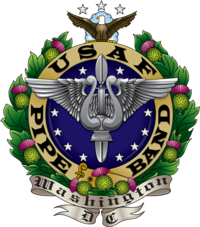The United States Air Force Pipe Band (USAF Pipe Band) was a highland unit of the United States Air Force. Organized in 1960 from a predecessor unit that had been activated in 1950, it was deactivated ten years later.
| United States Air Force Pipe Band | |
|---|---|
 Pipers of the Band of the Air Force Reserve Pipe Band, pictured with Sean Connery, in 2001. | |
| Active | 1960 – 1970 |
| Disbanded | 1970 |
| Country | |
| Branch | |
| Type | Military band |
| Garrison/HQ | Bolling AFB, Washington D.C. |
| Insignia | |
| Identification symbol |  |
| Identification symbol |  |
History
editThe USAF Pipe Band was activated in 1950 as a subordinate unit of the United States Air Force Drum and Bugle Corps at the instigation of the chief of headquarters command at Bolling Air Force Base.[1] Posted to Bolling Air Force Base throughout its existence, its first pipe major was "Scottie" Grubbs, formerly a piper in the Black Watch of the British Army.[1]
Due to USAF uniform regulations, the band was not initially authorized to wear highland dress, however, an intervention by Curtis LeMay subsequently allowed its adoption.[1][2]
Reestablished as an independent unit in 1960, it was deactivated in 1970 despite objections printed in several leading newspapers, including one penned by Russell Kirk.[3][4] Rumors that Gen. John Dale Ryan had ordered the unit's deactivation as part of an attempt to Americanize United States military bands were rejected by officials who stated the deactivation was for cost-cutting reasons.[3] The band's final pipe major, Norval 'Sandy' Jones, subsequently was appointed pipe major of The Citadel.[3]
Related units
editThe Band of the Air Force Reserve Pipe Band, a highland unit of the United States Air Force Reserve, was activated in 1970 and operated as a subordinate unit of the Band of the Air Force Reserve.[1][5] In September 2013 the Band of the Air Force Reserve, and with it the Band of the Air Force Reserve Pipe Band, was deactivated.[6] Following deactivation, a single piper was transferred to the United States Air Force Band as the service's sole remaining musician of this type.[7]
The Band of the Air Force Reserve Pipe Band wore a tartan from an unclaimed design by Strathmore Woollen Company of Forfar originally known as the Lady Jane of St Cirus tartan and subsequently registered with the Scottish Tartans Society as the "US Air Force Reserve Pipe Band tartan".[8]
See also
editReferences
edit- ^ a b c d Elting, John Robert. Military Uniforms in America: The Modern Era. Presidio Press. p. 130. ISBN 0891412921.
- ^ "USAF Pipe Band to Appear in Finleyville May 30". Daily Republican. 5 May 1969. Retrieved 21 August 2018.(subscription required)
- ^ a b c Barnes, John (July 1991). "United States Air Force Pipes and Drums". Journal of the International Military Music Society.
- ^ Kirk, Russell (25 February 1970). "No Skirling Pipes in the Air Force?". Indianapolis Star. Retrieved 21 August 2018.(subscription required)
- ^ Saltekoff, Alexy. "Air Force Reserve Pipe Band performs for president". af.mil. United States Air Force. Retrieved 21 August 2018.
- ^ "Band of AF Reserve returns from final deployment". af.mil. United States Air Force. Retrieved 21 August 2018.
- ^ McCray, Jake. "The Introspective Bagpiper". af.mil. United States Air Force. Retrieved 21 August 2018.
- ^ "Tartan Details - US Air Force Reserve Pipe Band". tartanregister.gov.uk. Scottish Tartans Authority. Retrieved 21 August 2018.